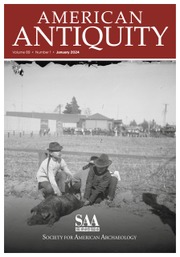No CrossRef data available.
Article contents
A New Method for Classifying Dart and Arrow Projectile Points
Published online by Cambridge University Press: 27 October 2025
Abstract
A long-standing classification problem in archaeology is determining the type of weapon delivery system used by people in the past. This is usually done by comparing archaeological points to known dart and arrow points from the ethnographic and archaeological record. There are no simple criteria to discriminate between these two states and the challenge is to identify a subset of traits and their interactions to solve this problem. Here we introduce a Bayesian technique of classifying dart and arrow. Using machine-learning feature selection, we first find the optimal set of variables for classification. We then use a Generalized Additive Model to model the interaction of these variables in a Bayesian logistic framework to capture the nonlinear decision boundary between darts and arrows and assign probabilities of a point belonging to either state. To counteract the imbalance of having more arrows than darts, we adjust the typical decision cutoff using an iterative approach that balances sensitivity and specificity. We increase the sample of known arrow and dart points with 102 previously published specimens from the West. The code for our model is available and easily accessible through an online application. We apply our model to published dart-versus-arrow classifications to demonstrate its utility.
Resumen
Un problema de clasificación de larga data en arqueología es determinar el tipo de sistema de lanzamiento de armas utilizado por las personas en el pasado. Esto generalmente se hace comparando puntas arqueológicas con puntas de dardos y flechas conocidas del registro etnográfico y arqueológico. No existen criterios simples para discriminar entre estos dos tipos, y el desafío consiste en identificar un subconjunto de rasgos y sus interacciones para resolver este problema. Aquí presentamos una técnica bayesiana para clasificar entre dardos y flechas. Utilizando una selección de características basada en aprendizaje automático, primero identificamos el conjunto óptimo de variables para la clasificación. Luego usamos un Modelo Aditivo Generalizado para modelar la interacción de estas variables en un marco logístico bayesiano, con el fin de capturar el límite de decisión no lineal entre dardos y flechas y asignar probabilidades a que una punta pertenezca a uno u otro tipo. Para contrarrestar el desequilibrio de tener más flechas que dardos, ajustamos el punto de corte típico de decisión utilizando un enfoque iterativo que equilibra la sensibilidad y la especificidad. Ampliamos la muestra de puntas de flechas y dardos conocidas con 102 especímenes previamente publicados del Oeste. El código de nuestro modelo está disponible y es fácilmente accesible a través de una aplicación en línea. Aplicamos nuestro modelo a clasificaciones publicadas de dardos versus flechas para demostrar su utilidad.
Keywords
Information
- Type
- Article
- Information
- Copyright
- © The Author(s), 2025. Published by Cambridge University Press on behalf of Society for American Archaeology.

